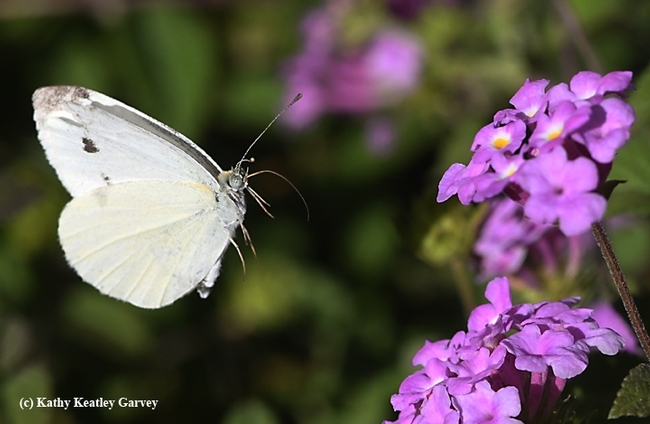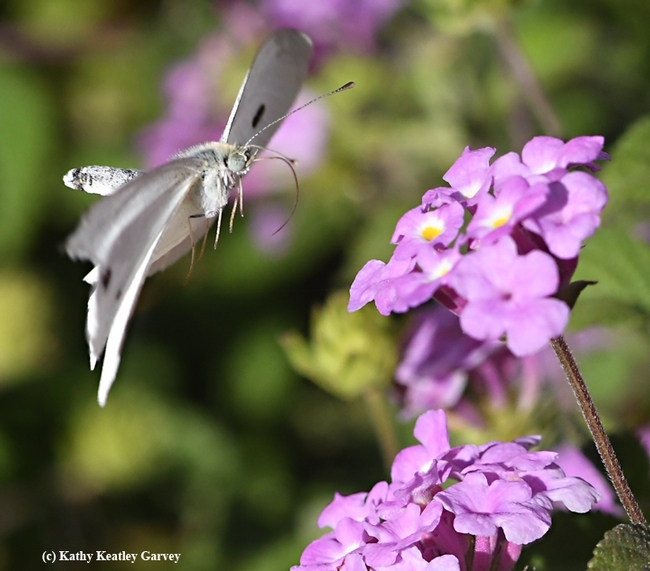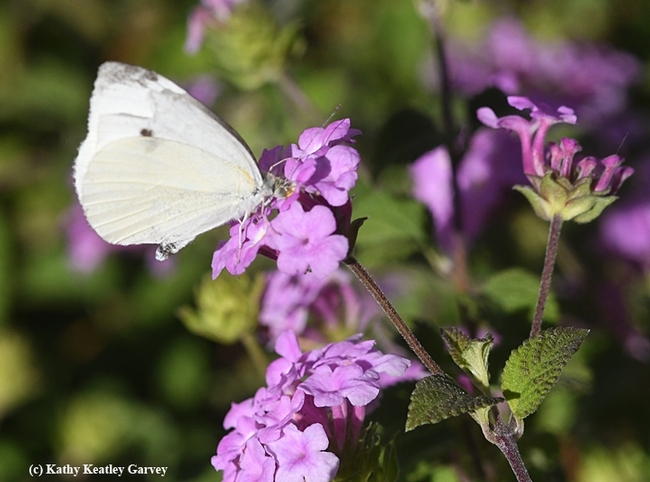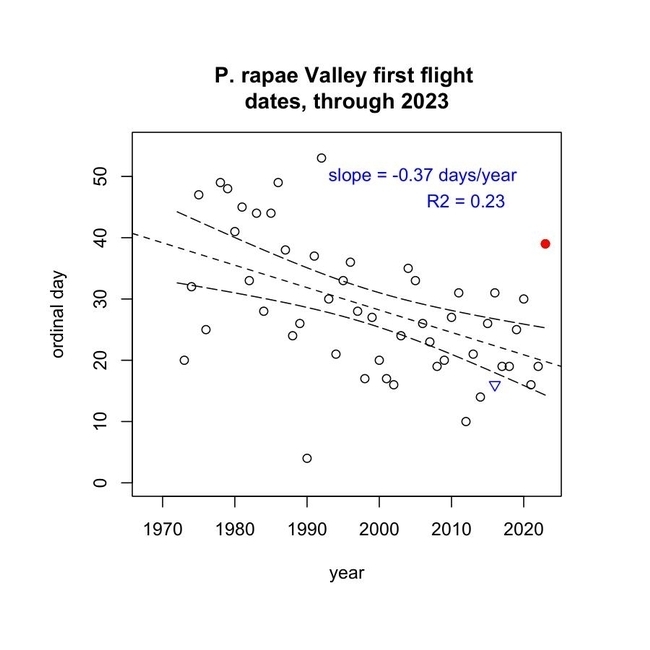- Author: Kathy Keatley Garvey
In its larval stage, it's a pest of cole crops.
As an adult, it's like a little Cinderella.
That would be the cabbage white butterfly, Pieris rapae.
In the fairy tale, a ragged Cinderella lives with her selfish stepmother and two mean stepsisters. Cinderella wants to attend the palace ball, but has nothing appropriate to wear. So her fairy godmother waves a magic wand and transforms her into a beautifully gowned princess, complete with glass slippers. She rides in a magnificent carriage pulled by a team of beautiful horses, dances with the prince, and at the stroke of midnight (when the magic ends), she loses a glass slipper. You know the rest. It all ends with Cinderella and the prince exchanging marriage vows and living happily after.
This butterfly appears in the spotlight every January when UC Davis emeritus professor Art Shapiro hosts his annual "Beer for a Butterfly" contest. Collect the first live butterfly of the year in the three-county area of Sacramento, Yolo and Solano and win a pitcher of beer. (See Bug Squad blog) It's all part of his scientific research long-term studies of butterfly life cycles and climate change.
Meanwhile, we see the cabbage white butterfly fluttering around the garden throughout most of the year, stopping for a little nectar here, a little nectar there.
She still reminds us of Cinderella, with a long flowing gown. Sometimes she looks a little ragged when a predator snatches part of her gown. But her magic never seems to end.
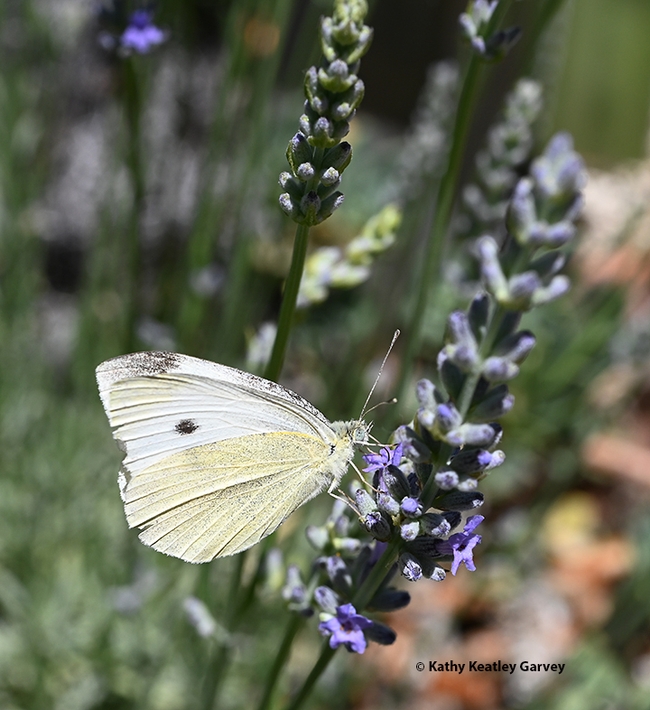
- Author: Kathy Keatley Garvey
If Cinderella were a butterfly, she'd probably be a white cabbage butterfly, Pieris rapae.
The butterfly--in its larval stage it's a pest of cucurbits--is stunning as an adult. Just think of a flowing white gown, exquisite pirouettes, and a flutter like no other.
If you've ever tried to photograph a white cabbage butterfly, it's not all that easy. They are fast and fleeting. One minute they're on the lavender and the next minute they're not. One minute they're on the catmint and then...
Where did they go?
With a fast shutter speed, though, you can sometimes catch them in flight.
When Cinderella left the ballroom at the stroke of midnight (she should listened to her Fairy Godmother and kept better track of her time!) her carriage turned back into a pumpkin, the footmen into lizards, the coachman into a rat, and her dress turned back into rags.
Just as her Fairy Godmother warned.
But the finely, timely P. rapae just flutters away--white flowing gown intact...unless snagged by a predator.
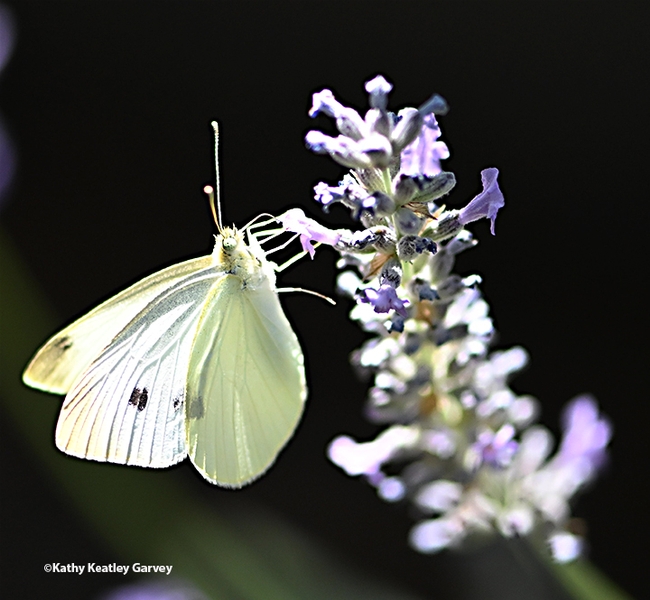
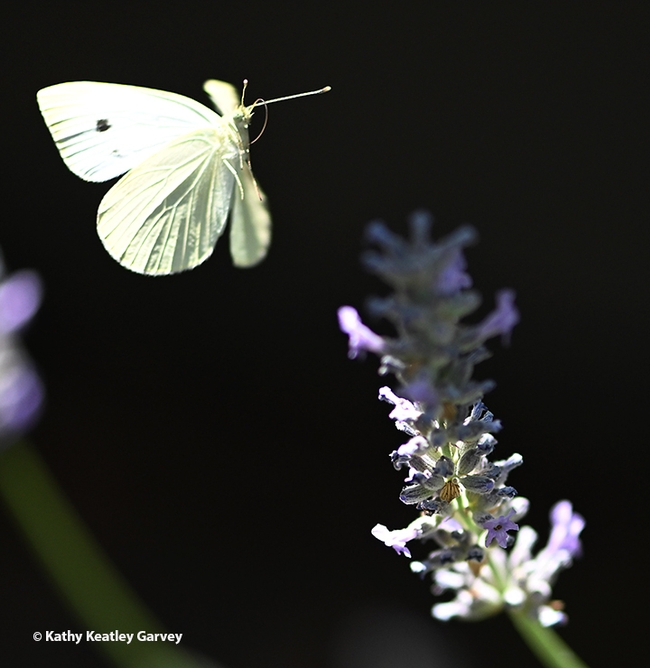
- Author: Kathy Keatley Garvey
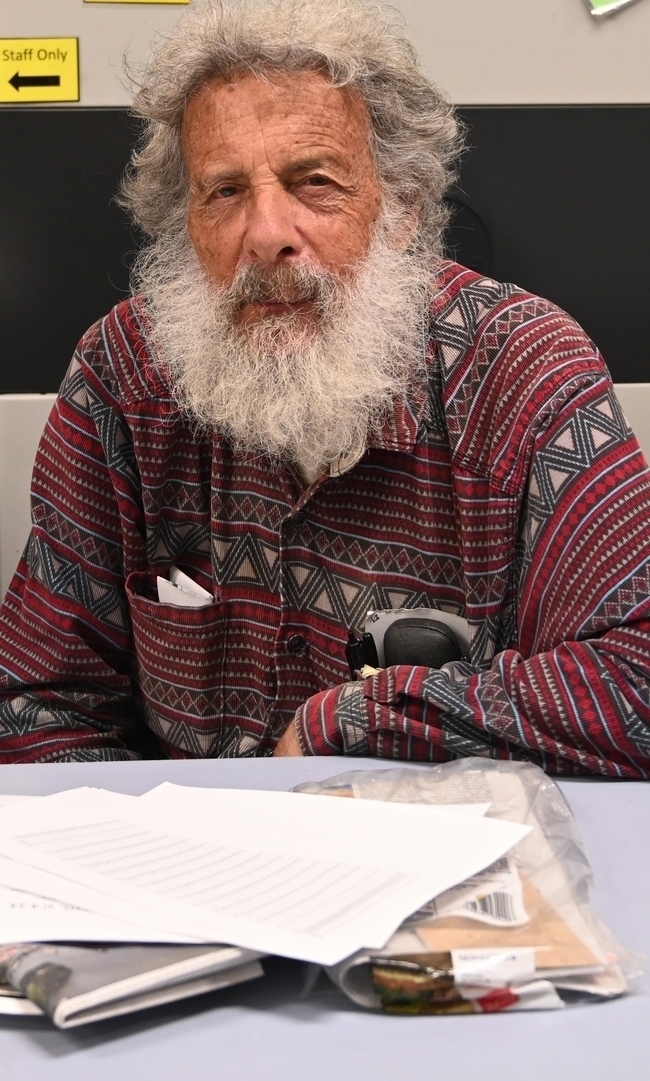
There's a good reason why.
Shapiro has monitored the butterfly populations of central California since 1972 and maintains a research site at https://butterfly.ucdavis.edu. "I began doing the 4th of July butterfly count in 1978 and have done it every year since--always on the actual Fourth," he emailed his "posse" today.
"As I read the models, the first week of July this year will be at or near record heat every day," Shapiro wrote. "The maximum should be 108 or 109 on Wednesday, and Thursday the 4th about 106 here (Davis, Calif.)"
"As most of you know, under such heat butterflies go into heat-avoidance mode," he pointed out. "Any data generated after the T (temperature) reaches 100F are suspect. Does anyone record butterfly diversity when things are known to not be flying?"
Shapiro quipped that he knows his limits "and I am not going to push them, even with a supply of intravenous Gatorade. If I do the Willow Slough count it will be after the T retreats to a civilized level, which may not be until about the 9th or 10th."
"At any rate, don't expect a report on Thursday."
Note: You may know Shapiro not only for his incredible butterfly population data, but also for the "Beer for a Butterfly" contest he hosts every year in the three-county area of Sacramento, Yolo and Solano. The first person to net the first-of-the-year cabbage white butterfly, Pieris rapae, and win the contest receives a pitcher of beer or its equivalent. It's all part of his scientific research. P. rapae is emerging earlier and earlier as the regional climate has warmed, Shapiro says. (See Bug Squad post)
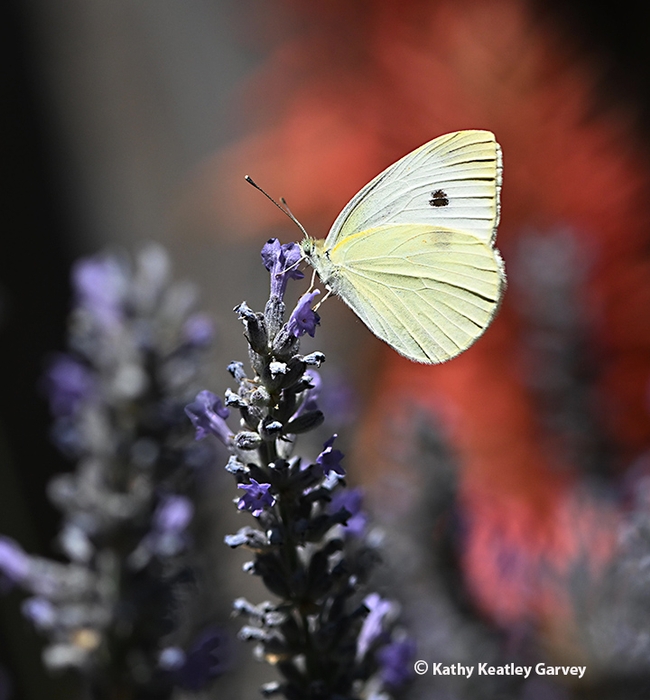
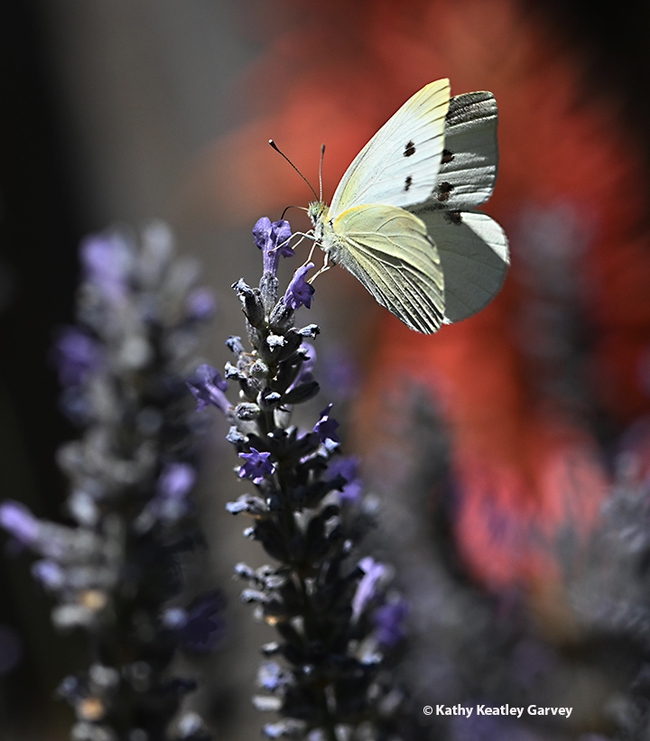
- Author: Kathy Keatley Garvey
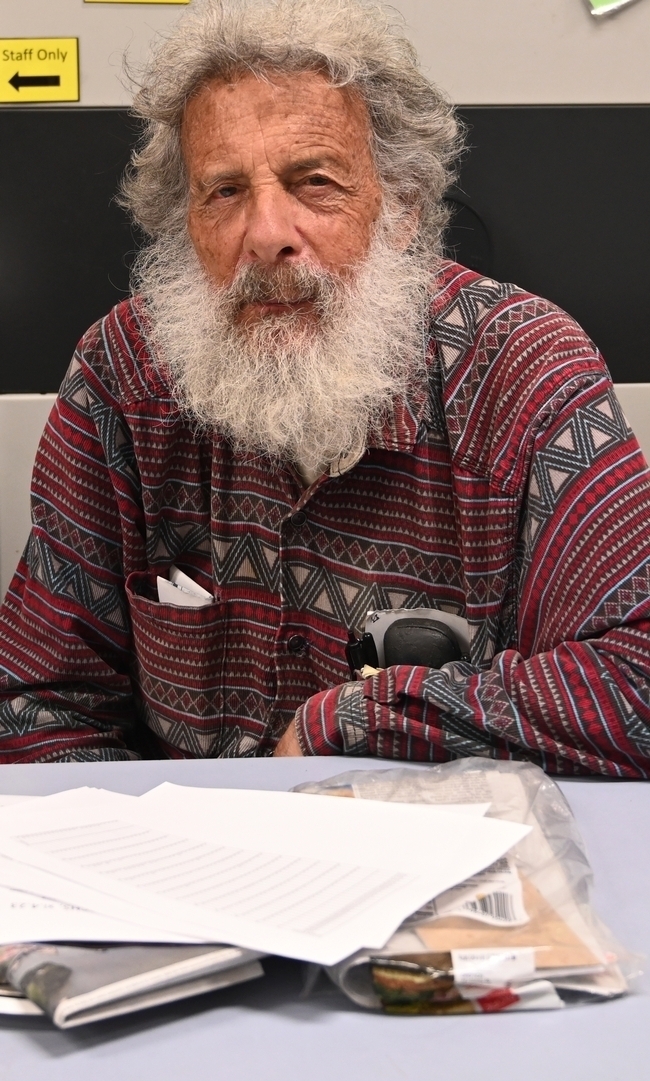
We have a winner in the annual Beer-for-a-Butterfly Contest, in which the first person to collect the first cabbage white butterfly of the year in the three-county area of Yolo, Sacramento and Solano, wins a beer.
The 2024 winner of the "Suds for a Bug" contest?
The repeat winner, UC Davis distinguished professor emeritus Art Shapiro. He has sponsored the annual contest since 1972 as part of his scientific research involving long-term studies of butterfly life cycles and climate change. He also participates in his own contest.
In its larval stage, the cabbage white butterfly, Pieris rapae, is a pest of cole crops, including cabbage, cauliflower and broccoli.
Shapiro did not actually collect the butterfly; he recorded it. But no person came forth with an eligible entry.
Shapiro spotted the cabbage white on Monday, Jan. 29 at 11:30 a.m. in West Sacramento, Yolo County, and saw the same one again at 11:40.
As he related in his posse email: “Went to West Sac bright and early, direct from breakfast and without a net. Light ground fog broke up by 9:30 a.m. and thereafter it was clear until around 2, when high, thin overcast moved in rapidly from the west. Before it clouded over, it hit 73F, with light and variable wind. Once the clouds moved in, although they were translucent, the temperature dropped quickly into the 60s. There are a few Brassica kaber (mustard) and a couple of dozen Raphanus (wild radish) in bloom, a tiny fraction of what was around last year at the end of January."
“Saw my first rapae of 2024, a male, at 11.20 a.m. and the same one again at 11.40. Then nothing until 12:20--another male, certainly a different one, 1.5 miles farther west. Nothing else seen, so 1(2) for the day.”
The emeritus professor said he learned that someone “may have gotten one yesterday (Jan. 28), location unknown, but no one came forth." He also received a report of one collected on Jan. 22 in Davis "which almost certainly hatched indoors so I'm not counting it. It was found in the person's apartment at 7 p.m., but never seen to come in from outdoors."
Shapiro, who has monitored butterfly populations in Central California since 1972, and maintains a research website at http://butterfly.ucdavis.edu/, says the point of the contest "is to get the earliest possible flight date for statistical purposes. The rules require that the animal be captured and brought in alive to be verified. That way no one can falsely claim to have seen one or misidentify something else as a cabbage white."
The contest rules include:
- It must be an adult (no caterpillars or pupae) and be captured outdoors.
- It must be brought in alive to the Bohart Museum of Entomology, located in Room 1124, Academic Surge Building, 455 Crocker Lane, UC Davis campus, during work hours, from 8 a.m. to noon, and from 1 to 5 p.m., Monday through Friday. It must include full data (exact time, date and location of the capture) and the contact information of the collector (address, phone number and/or e-mail.) Brennen Dyer will certify that it is alive and refrigerate it. (If it's collected on a weekend or holiday, it can be kept in the refrigerator for a few days--do not freeze it, Shapiro says.)
- Shapiro is the sole judge.
Brennen related no one brought a white cabbage butterfly to the Bohart Museum to compete in the contest.
P. rapae is emerging earlier and earlier as the regional climate has warmed, Shapiro says. "Since 1972, the first flight of the cabbage white butterfly has varied from Jan. 1 to Feb. 22, averaging about Jan. 20."
Shapiro has been defeated only four times and those were by UC Davis graduate students. Adam Porter won in 1983; Sherri Graves and Rick VanBuskirk each won in the late 1990s; and Jacob Montgomery in 2016. The first three were his own graduate students.
Who won in 2023? Shapiro spotted the first butterfly of 2023 at 11:22 a.m., in West Sacramento. He did not collect the butterfly but recorded it as the first of the year. No one came forth with a competitor.
Matthew Forister, the Foundation Professor, Trevor J. McMinn Endowed Research Professor in Biology at the University of Nevada, Reno, collaborates with Shapiro and annually creates a graph, using statistics from 1972 to the current year. "The long-term linear pattern continues, although recent years have been less steep (the year slope was -0.45 six years ago; is -0.34 now)," he related. Forister received his PhD in ecology from UC Davis in 2004, studying with Shapiro.
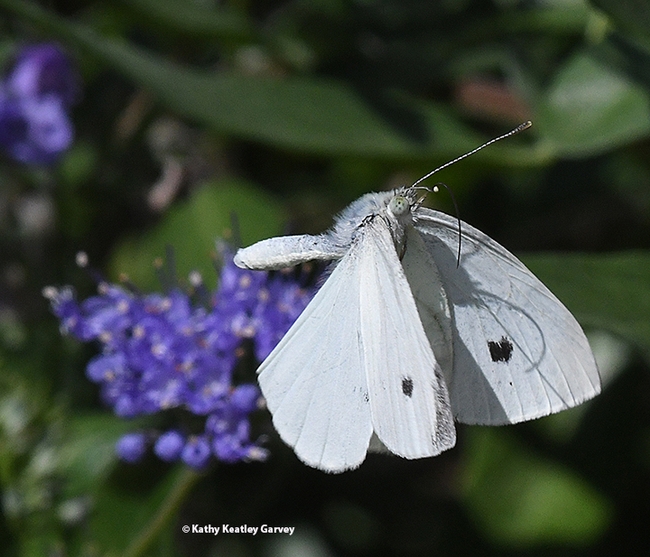
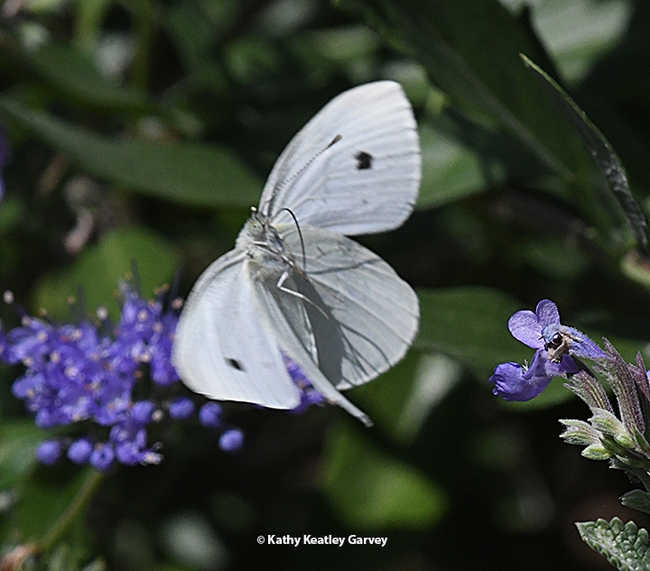
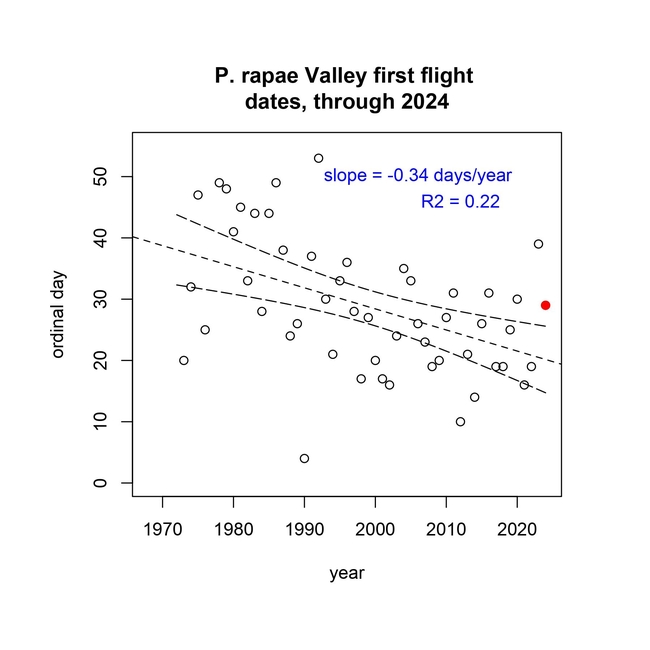
- Author: Kathy Keatley Garvey
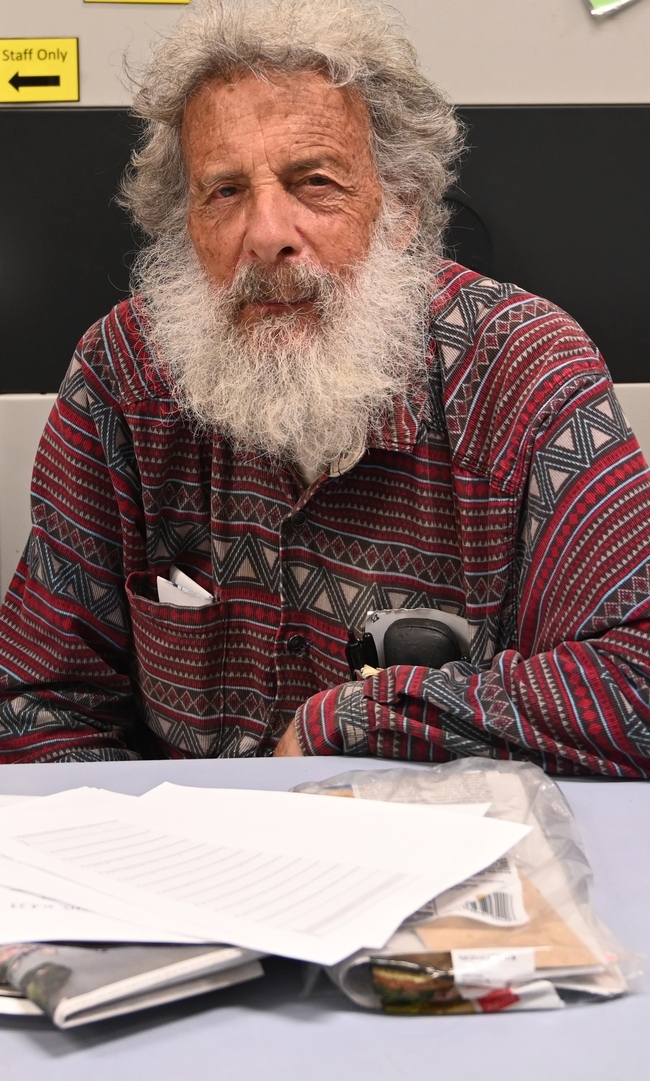
It's almost time for the Art Shapiro's annual "Beer-for-a-Butterfly" contest that he's sponsored since 1972. The person who finds the first-of-the-year cabbage white butterfly, Pieris rapae, in the three-county area of Yolo, Sacramento and Solano, wins a beer--or its equivalent.
And bragging rights!
Shapiro, UC Davis distinguished professor emeritus, Department of Evolution and Ecology, is retired, but not from his research and not from sponsoring the annual “Beer-for-a-Butterfly” contest.
Beginning Jan. 1, 2024, Shapiro will be collaborating with the Bohart Museum of Entomology, the "dropping off point," for the entries. Bohart curator and collections manager Brennen Dyer will be accepting the entries.
Shapiro launched the contest a half a century ago as part of his scientific research to determine the first flight of the year in the three-county area. His research involves long-term studies of butterfly life cycles and climate change.
Shapiro says P. rapae is emerging earlier and earlier as the regional climate has warmed. "Since 1972, the first flight of the cabbage white butterfly has varied from Jan. 1 to Feb. 22, averaging about Jan. 20."
Shapiro, who maintains a research website at http://butterfly.ucdavis.edu/, says the point of the contest "is to get the earliest possible flight date for statistical purposes. The rules require that the animal be captured and brought in alive to be verified. That way no one can falsely claim to have seen one or misidentify something else as a cabbage white."
The contest rules include:
- It must be an adult (no caterpillars or pupae) and be captured outdoors.
- It must be brought in alive to the Bohart Museum of Entomology, located in Room 1124, Academic Surge Building, 455 Crocker Lane, UC Davis campus, during work hours, from 8 a.m. to noon, and from 1 to 5 p.m., Monday through Friday. It must include full data (exact time, date and location of the capture) and the contact information of the collector (address, phone number and/or e-mail.) Brennen Dyer will certify that it is alive and refrigerate it. (If it's collected on a weekend or holiday, it can be kept in the refrigerator for a few days--do not freeze it, Shapiro says.)
- Shapiro is the sole judge.
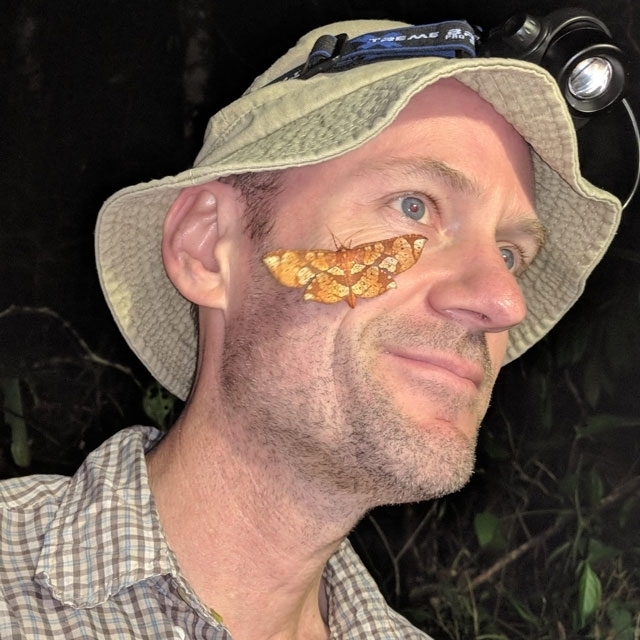
Feb 8 was "the 11th latest first rapae day since 1972,” he said, detailing the 10 later finds: Feb. 26, 1972 (“which is probably too late, since I hadn't yet learned where to look for them first!”); Feb. 22, 1992 (“I fully believe that one”); Feb. 18, 1978 and 1986; Feb. 17, 1979; Feb. 16, 1975; Feb. 14, 1981; Feb. 13, 1983 and 1985; and Feb. 10, 1980. “Note that most of these are from the '80s,” he said. “There has indeed been a trend to earlier emergence, though this year is an outlier!”
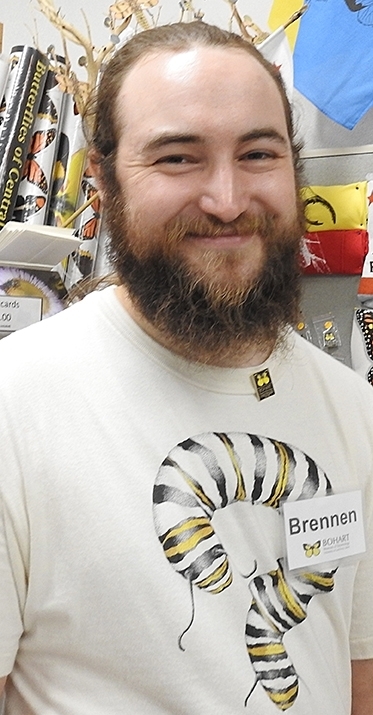
Shapiro, who monitors butterfly populations in the field for more than 200 days of the year, participates in his own contest. He has been defeated only four times and those were by UC Davis graduate students. Adam Porter won in 1983; Sherri Graves and Rick VanBuskirk each won in the late 1990s; and Jacob Montgomery in 2016. The first three were his own graduate students.
Shapiro nets many of the winners in mustard patches near railroad tracks in West Sacramento, Yolo County
Recent Beer-for-a-Butterfly Contest statistics:
- 2023: Art Shapiro recorded the first butterfly of the year at 11:22 a.m., Feb 8 in West Sacramento County, Yolo County. He did not collect the specimen and no one can forth with a winner.
- 2022: No official contest due to the COVID pandemic, but Shapiro recorded his first-of-the-year P. rapae at 1:25 p.m. on Jan. 19 in West Sacramento, Yolo County
- 2021: No official contest due to the COVID pandemic, but Shapiro collected his first-of-the-year at 1:55 p.m. Jan. 16 on the UC Davis campus, Yolo County
- 2020: Technically, no winner, as Shapiro did not collect the one he spotted in Winters, Yolo County at 11:16 a.m. on Jan. 30 at the Putah Creek Nature Park. "It flew back and forth across Putah Creek and then departed the area, flying out of reach above the trees," he noted. He waited around for 90 minutes to see if it would return. It did not.
- 2019: Shapiro collected the first cabbage white butterfly near the Suisun Yacht Club, Suisun City, Solano County, at 1:12 p.m., Friday, Jan. 25. "It was the earliest recorded in Suisun City in 47 seasons."
- 2018: Art Shapiro collected the winner in West Sacramento
- 2017: Jan. 19: Art Shapiro collected the winner on the UC Davis campus
- 2016: Jan. 16: Jacob Montgomery collected the winner in west Davis
- 2015: Jan. 26: Shapiro collected the winner in West Sacramento
- 2014: Jan. 14: Shapiro collected the winner in West Sacramento
- 2013: Jan. 21: Shapiro collected the winner in West Sacramento
- 2012: Jan. 8: Shapiro collected the winner in West Sacramento
- 2011: Jan. 31: Shapiro collected the winner in Suisun
- 2010: Jan. 27: Shapiro collected the winner in West Sacramento
A fellow of the American Association for the Advancement of Science, the Royal Entomological Society and the California Academy of Sciences, Shapiro is the author of A Field Guide to Butterflies of the San Francisco Bay and Sacramento Valley Regions, illustrated by Tim Manolis and published in 2007 by the University of California Press.
Collaborating with Shapiro on butterfly research projects is Foundation Professor Matthew Forister, the Trevor J. McMinn Endowed Research Professor in Biology, University of Nevada. Forister received his doctorate from UC Davis, studying with Shapiro, his major professor.
Pest of Cole Crops. As a caterpillar, the insect is a pest of cole crops such as cabbage. UC Statewide Integrated Pest Management Program (UC IPM) says the cabbageworm is active throughout the year in California. "Cabbageworm larvae chew large, irregular holes in leaves, bore into heads, and drop greenish brown fecal pellets that may contaminate the marketed product. Seedlings may be damaged, but most losses are due to damage to marketed parts of the plant," according to the UC IPM website.
The Bohart Museum of Entomology is directed by UC Davis distinguished professor Lynn Kimsey. Entomologist Jeff Smith curates the Lepidoptera collection, a global collection of some 500,000 moths and butterflies.
